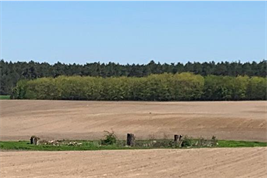27.10.2025

When fertile topsoil is eroded by rain or tillage, this has consequences that go beyond mere soil loss. A new study led by the Thünen Institute of Climate-Smart Agriculture and the Leibniz Centre for Agricultural Landscape Research (ZALF), published in the journal Soil Biology and Biochemistry, shows that Erosion slows down the rate of the nitrogen cycle in the soil and reduces the emission of the greenhouse gas nitrous oxide. At the same time, however, the availability of nutrients for plants decreases - a challenge for agriculture.
Insight into the experiment
In order to investigate the effects of erosion, the researchers produced eroded soil by mixing different proportions of subsoil into the topsoil. Three variants were compared in a laboratory experiment under controlled conditions: Soils without erosion, soils with slight erosion and soils with severe erosion. The greater the degree of erosion, the more fertile topsoil had already been lost. While the non-eroded soil consisted entirely of nutrient-rich, dark topsoil, the slightly and more severely eroded soils contained increasingly more subsoil. Maize served as the test plant in the experiment. To track the nitrogen, the researchers used isotopically labeled nitrogen ((15) N). This made it possible to observe exactly how nitrogen moves in the soil, is converted into other substances and ultimately escapes in the form of gases such as nitrous oxide or dinitrogen.
Erosion reduces process speed
The results show that in heavily eroded soils, the amount of organic carbon and nitrogen decreased by around a third. This meant that the most important "fuels" for soil microorganisms, which normally convert nitrogen compounds very actively, were missing. In particular, the conversion of ammonium to nitrate, a central process in the nitrogen cycle, was reduced by almost half in the experiment.
Less nitrous oxide - but also fewer nutrients
As the conversion processes slowed down, emissions also decreased: in soils without plants, around 51 micrograms of nitrous oxide per kilogram of soil were produced every day in the experiment without erosion. In heavily eroded soils, the figure was only 2.5 micrograms - a reduction of around 95 percent. Overall, nitrous oxide losses due to erosion fell by more than 80 percent. At the same time, significantly less mineral nitrogen was available to the plants.
Plants amplify processes
The researchers observed that young maize plants intensified the nitrogen conversion processes in the soil. The release of root excretions provided microorganisms with additional nutrients, which in some cases doubled the emissions from the soil. Nevertheless, the degree of erosion influenced the emissions more than the plants.
"Our results show that erosion slows down the nitrogen conversion processes in soils. Although this reduces emissions, it also restricts the nutrient supply for the plants. Erosion control and fertilization strategies must therefore be considered together," explains Julia Schoof, who carried out the experiment at the Thünen Institute.
Importance for agriculture and climate protection
Around half of Europe's arable land is considered to be at risk of erosion. This makes the problem significant not only for farmers, but also for climate protection. Because if less nitrogen is applied, greenhouse gas emissions are reduced, but at the same time the growing conditions for crops deteriorate. The study shows that erosion control measures must be given greater consideration in future in order to ensure both the productivity of soils and their climate impact in the long term.
These initial results come from a seven-day laboratory study under controlled conditions. As a next step, field studies over longer periods of time are planned in order to verify the observations under real cultivation conditions.
Further information:
Original publication (Open Access):
https://doi.org/10.1016/j.soilbio.2025.109905
Note on the text:
This is a summary of the original text created with the help of artificial intelligence: Schoof, J.; Holz, M.; Rütting, T.; Well, R.; Buchen-Tschiskale, C. (2025): Impact of different soil erosion levels on gross N transformation processes and gaseous N losses: An incubation study. Soil Biology and Biochemistry 209, 109905. DOI:
https://doi.org/10.1016/j.soilbio.2025.109905, , published Open Access / under license CC BY 4.0
https://creativecommons.org/licenses/by/4.0/. The text was carefully reviewed and revised under the aspects of
AI-regulations at ZALF.
Project partner:
Leibniz Center for Agricultural Landscape Research (ZALF), Müncheberg (DE)
Humboldt University of Berlin, Thaer Institute (DE)
University of Gothenburg, Department of Earth Sciences (SE)
Thünen Institute of Climate-Smart Agriculture, Braunschweig (DE)
Funding reference:
This study was funded by the German Research Foundation (DFG) (project numbers BU 3719/3-1 und HO 6381/4-1).
